2009 LINCOLN TOWN CAR jump start
[x] Cancel search: jump startPage 2 of 280
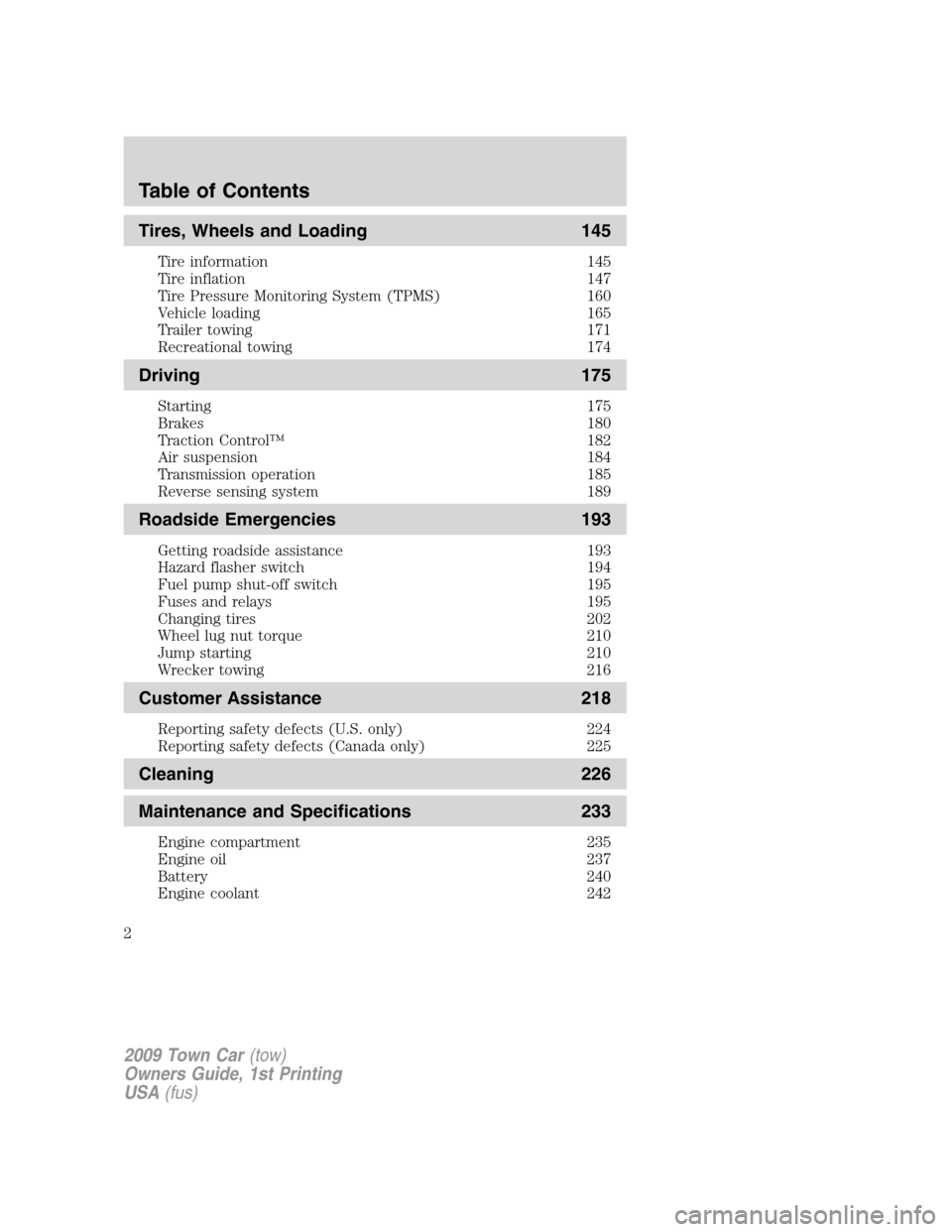
Tires, Wheels and Loading 145
Tire information 145
Tire inflation 147
Tire Pressure Monitoring System (TPMS) 160
Vehicle loading 165
Trailer towing 171
Recreational towing 174
Driving 175
Starting 175
Brakes 180
Traction Control™ 182
Air suspension 184
Transmission operation 185
Reverse sensing system 189
Roadside Emergencies 193
Getting roadside assistance 193
Hazard flasher switch 194
Fuel pump shut-off switch 195
Fuses and relays 195
Changing tires 202
Wheel lug nut torque 210
Jump starting 210
Wrecker towing 216
Customer Assistance 218
Reporting safety defects (U.S. only) 224
Reporting safety defects (Canada only) 225
Cleaning 226
Maintenance and Specifications 233
Engine compartment 235
Engine oil 237
Battery 240
Engine coolant 242
Table of Contents
2
2009 Town Car(tow)
Owners Guide, 1st Printing
USA(fus)
Page 193 of 280
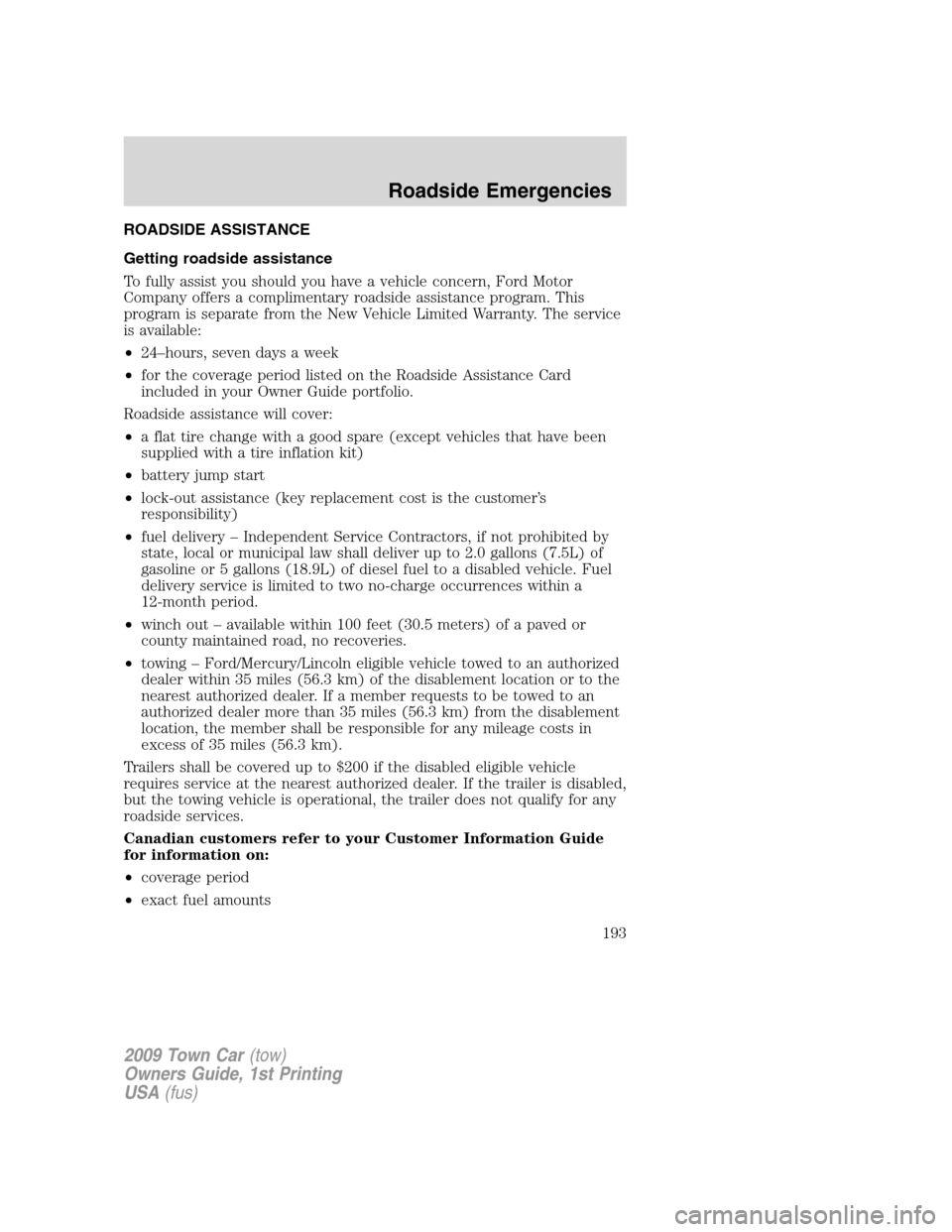
ROADSIDE ASSISTANCE
Getting roadside assistance
To fully assist you should you have a vehicle concern, Ford Motor
Company offers a complimentary roadside assistance program. This
program is separate from the New Vehicle Limited Warranty. The service
is available:
•24–hours, seven days a week
•for the coverage period listed on the Roadside Assistance Card
included in your Owner Guide portfolio.
Roadside assistance will cover:
•a flat tire change with a good spare (except vehicles that have been
supplied with a tire inflation kit)
•battery jump start
•lock-out assistance (key replacement cost is the customer’s
responsibility)
•fuel delivery – Independent Service Contractors, if not prohibited by
state, local or municipal law shall deliver up to 2.0 gallons (7.5L) of
gasoline or 5 gallons (18.9L) of diesel fuel to a disabled vehicle. Fuel
delivery service is limited to two no-charge occurrences within a
12-month period.
•winch out – available within 100 feet (30.5 meters) of a paved or
county maintained road, no recoveries.
•towing – Ford/Mercury/Lincoln eligible vehicle towed to an authorized
dealer within 35 miles (56.3 km) of the disablement location or to the
nearest authorized dealer. If a member requests to be towed to an
authorized dealer more than 35 miles (56.3 km) from the disablement
location, the member shall be responsible for any mileage costs in
excess of 35 miles (56.3 km).
Trailers shall be covered up to $200 if the disabled eligible vehicle
requires service at the nearest authorized dealer. If the trailer is disabled,
but the towing vehicle is operational, the trailer does not qualify for any
roadside services.
Canadian customers refer to your Customer Information Guide
for information on:
•coverage period
•exact fuel amounts
2009 Town Car(tow)
Owners Guide, 1st Printing
USA(fus)
Roadside Emergencies
193
Page 210 of 280
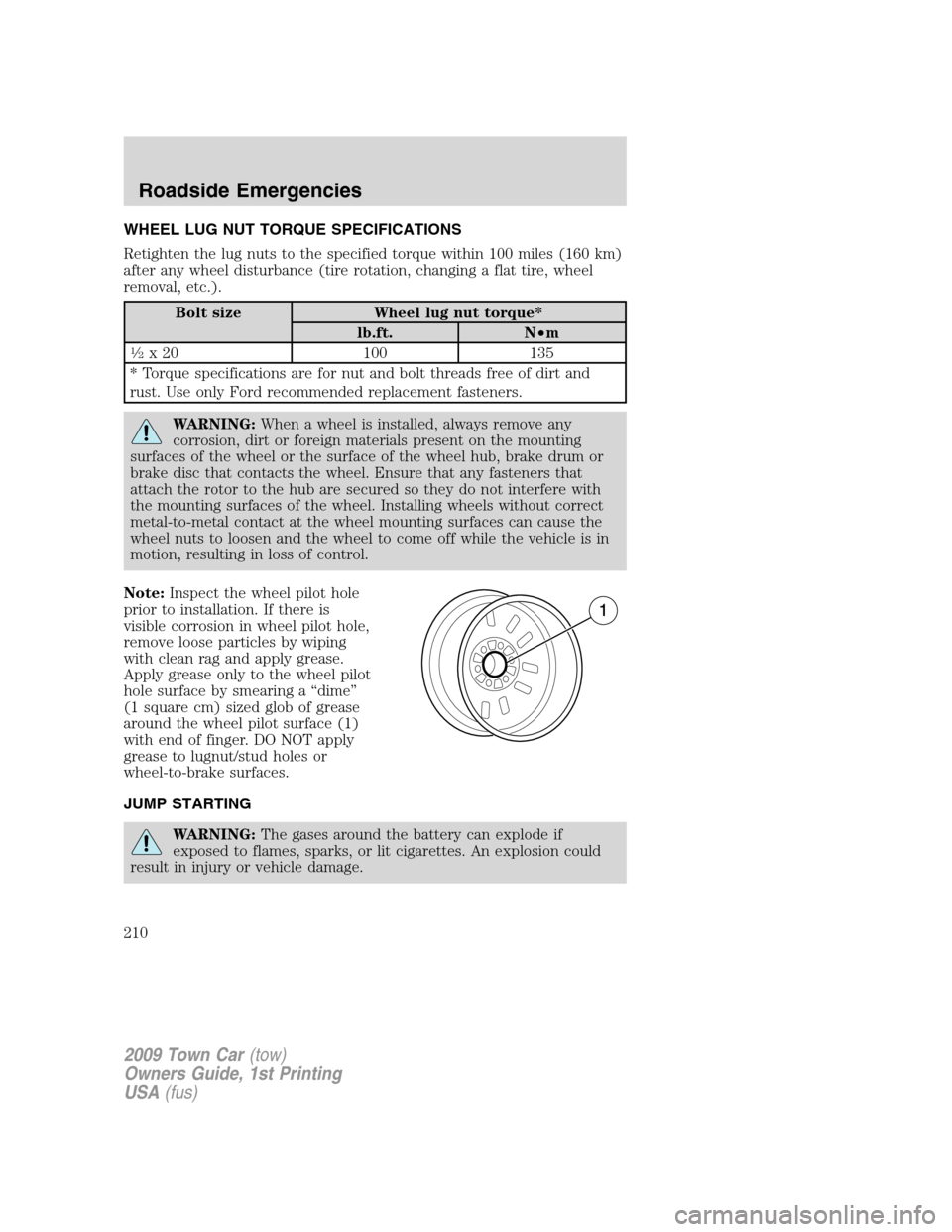
WHEEL LUG NUT TORQUE SPECIFICATIONS
Retighten the lug nuts to the specified torque within 100 miles (160 km)
after any wheel disturbance (tire rotation, changing a flat tire, wheel
removal, etc.).
Bolt size Wheel lug nut torque*
lb.ft. N•m
1�2x 20 100 135
* Torque specifications are for nut and bolt threads free of dirt and
rust. Use only Ford recommended replacement fasteners.
WARNING:When a wheel is installed, always remove any
corrosion, dirt or foreign materials present on the mounting
surfaces of the wheel or the surface of the wheel hub, brake drum or
brake disc that contacts the wheel. Ensure that any fasteners that
attach the rotor to the hub are secured so they do not interfere with
the mounting surfaces of the wheel. Installing wheels without correct
metal-to-metal contact at the wheel mounting surfaces can cause the
wheel nuts to loosen and the wheel to come off while the vehicle is in
motion, resulting in loss of control.
Note:Inspect the wheel pilot hole
prior to installation. If there is
visible corrosion in wheel pilot hole,
remove loose particles by wiping
with clean rag and apply grease.
Apply grease only to the wheel pilot
hole surface by smearing a “dime”
(1 square cm) sized glob of grease
around the wheel pilot surface (1)
with end of finger. DO NOT apply
grease to lugnut/stud holes or
wheel-to-brake surfaces.
JUMP STARTING
WARNING:The gases around the battery can explode if
exposed to flames, sparks, or lit cigarettes. An explosion could
result in injury or vehicle damage.
2009 Town Car(tow)
Owners Guide, 1st Printing
USA(fus)
Roadside Emergencies
210
Page 211 of 280
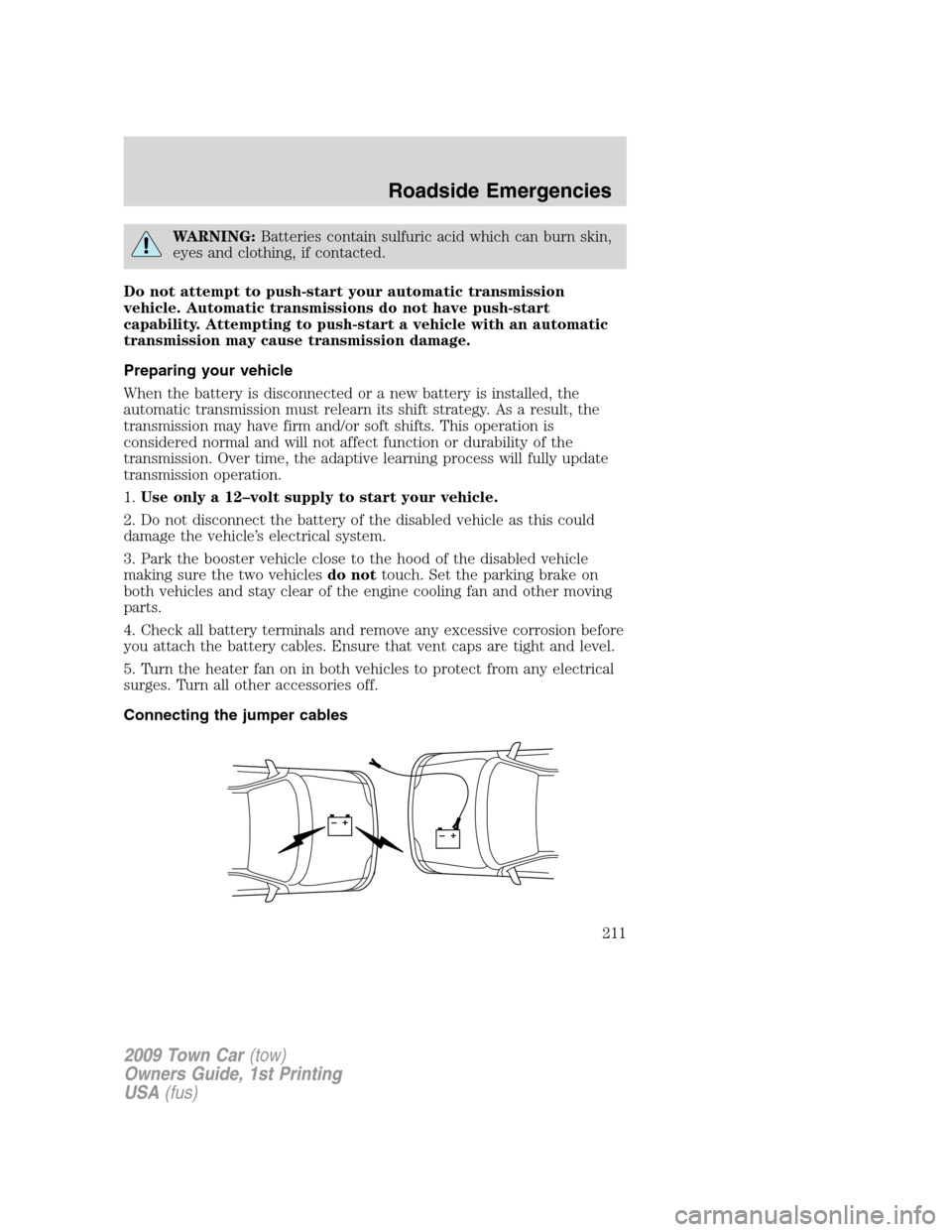
WARNING:Batteries contain sulfuric acid which can burn skin,
eyes and clothing, if contacted.
Do not attempt to push-start your automatic transmission
vehicle. Automatic transmissions do not have push-start
capability. Attempting to push-start a vehicle with an automatic
transmission may cause transmission damage.
Preparing your vehicle
When the battery is disconnected or a new battery is installed, the
automatic transmission must relearn its shift strategy. As a result, the
transmission may have firm and/or soft shifts. This operation is
considered normal and will not affect function or durability of the
transmission. Over time, the adaptive learning process will fully update
transmission operation.
1.Use only a 12–volt supply to start your vehicle.
2. Do not disconnect the battery of the disabled vehicle as this could
damage the vehicle’s electrical system.
3. Park the booster vehicle close to the hood of the disabled vehicle
making sure the two vehiclesdo nottouch. Set the parking brake on
both vehicles and stay clear of the engine cooling fan and other moving
parts.
4. Check all battery terminals and remove any excessive corrosion before
you attach the battery cables. Ensure that vent caps are tight and level.
5. Turn the heater fan on in both vehicles to protect from any electrical
surges. Turn all other accessories off.
Connecting the jumper cables
+–+–
2009 Town Car(tow)
Owners Guide, 1st Printing
USA(fus)
Roadside Emergencies
211
Page 213 of 280
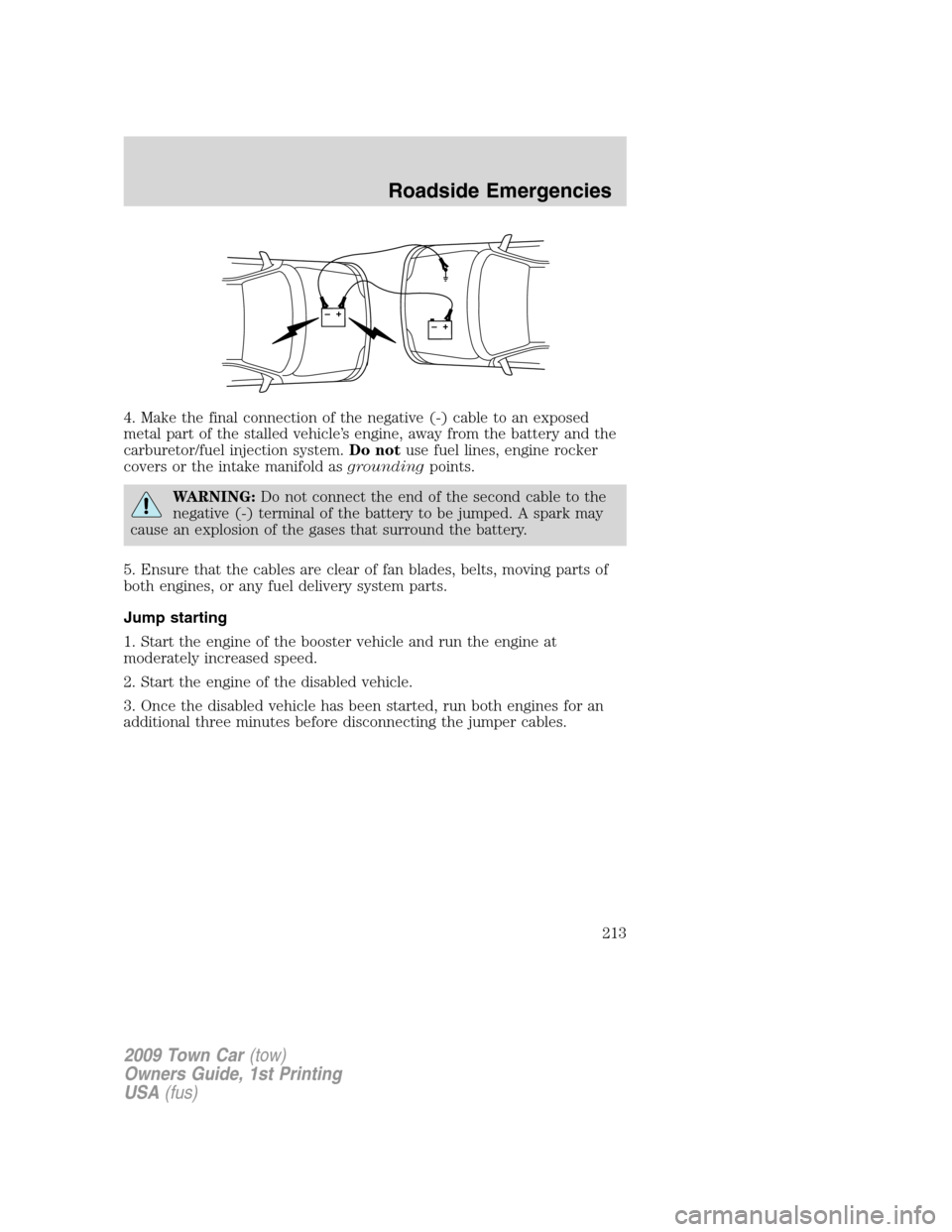
4. Make the final connection of the negative (-) cable to an exposed
metal part of the stalled vehicle’s engine, away from the battery and the
carburetor/fuel injection system.Do notuse fuel lines, engine rocker
covers or the intake manifold asgroundingpoints.
WARNING:Do not connect the end of the second cable to the
negative (-) terminal of the battery to be jumped. A spark may
cause an explosion of the gases that surround the battery.
5. Ensure that the cables are clear of fan blades, belts, moving parts of
both engines, or any fuel delivery system parts.
Jump starting
1. Start the engine of the booster vehicle and run the engine at
moderately increased speed.
2. Start the engine of the disabled vehicle.
3. Once the disabled vehicle has been started, run both engines for an
additional three minutes before disconnecting the jumper cables.
+–+–
2009 Town Car(tow)
Owners Guide, 1st Printing
USA(fus)
Roadside Emergencies
213
Page 215 of 280

3. Remove the jumper cable from the positive (+) terminal of the booster
vehicle’s battery.
4. Remove the jumper cable from the positive (+) terminal of the
disabled vehicle’s battery.
After the disabled vehicle has been started and the jumper cables
removed, allow it to idle for several minutes so the engine computer can
relearnits idle conditions.
+–+–
+–+–
2009 Town Car(tow)
Owners Guide, 1st Printing
USA(fus)
Roadside Emergencies
215
Page 276 of 280
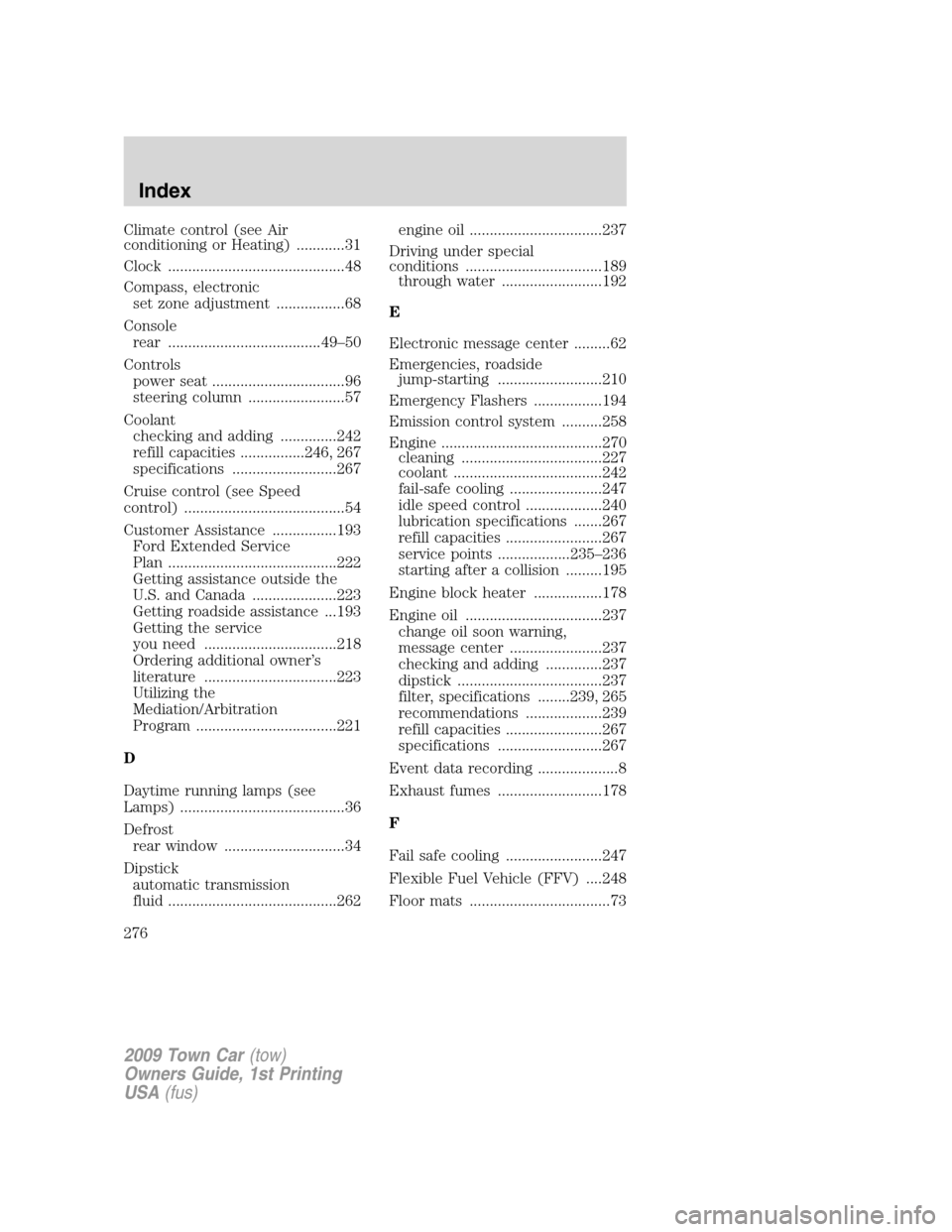
Climate control (see Air
conditioning or Heating) ............31
Clock ............................................48
Compass, electronic
set zone adjustment .................68
Console
rear ......................................49–50
Controls
power seat .................................96
steering column ........................57
Coolant
checking and adding ..............242
refill capacities ................246, 267
specifications ..........................267
Cruise control (see Speed
control) ........................................54
Customer Assistance ................193
Ford Extended Service
Plan ..........................................222
Getting assistance outside the
U.S. and Canada .....................223
Getting roadside assistance ...193
Getting the service
you need .................................218
Ordering additional owner’s
literature .................................223
Utilizing the
Mediation/Arbitration
Program ...................................221
D
Daytime running lamps (see
Lamps) .........................................36
Defrost
rear window ..............................34
Dipstick
automatic transmission
fluid ..........................................262engine oil .................................237
Driving under special
conditions ..................................189
through water .........................192
E
Electronic message center .........62
Emergencies, roadside
jump-starting ..........................210
Emergency Flashers .................194
Emission control system ..........258
Engine ........................................270
cleaning ...................................227
coolant .....................................242
fail-safe cooling .......................247
idle speed control ...................240
lubrication specifications .......267
refill capacities ........................267
service points ..................235–236
starting after a collision .........195
Engine block heater .................178
Engine oil ..................................237
change oil soon warning,
message center .......................237
checking and adding ..............237
dipstick ....................................237
filter, specifications ........239, 265
recommendations ...................239
refill capacities ........................267
specifications ..........................267
Event data recording ....................8
Exhaust fumes ..........................178
F
Fail safe cooling ........................247
Flexible Fuel Vehicle (FFV) ....248
Floor mats ...................................73
2009 Town Car(tow)
Owners Guide, 1st Printing
USA(fus)
Index
276
Page 277 of 280
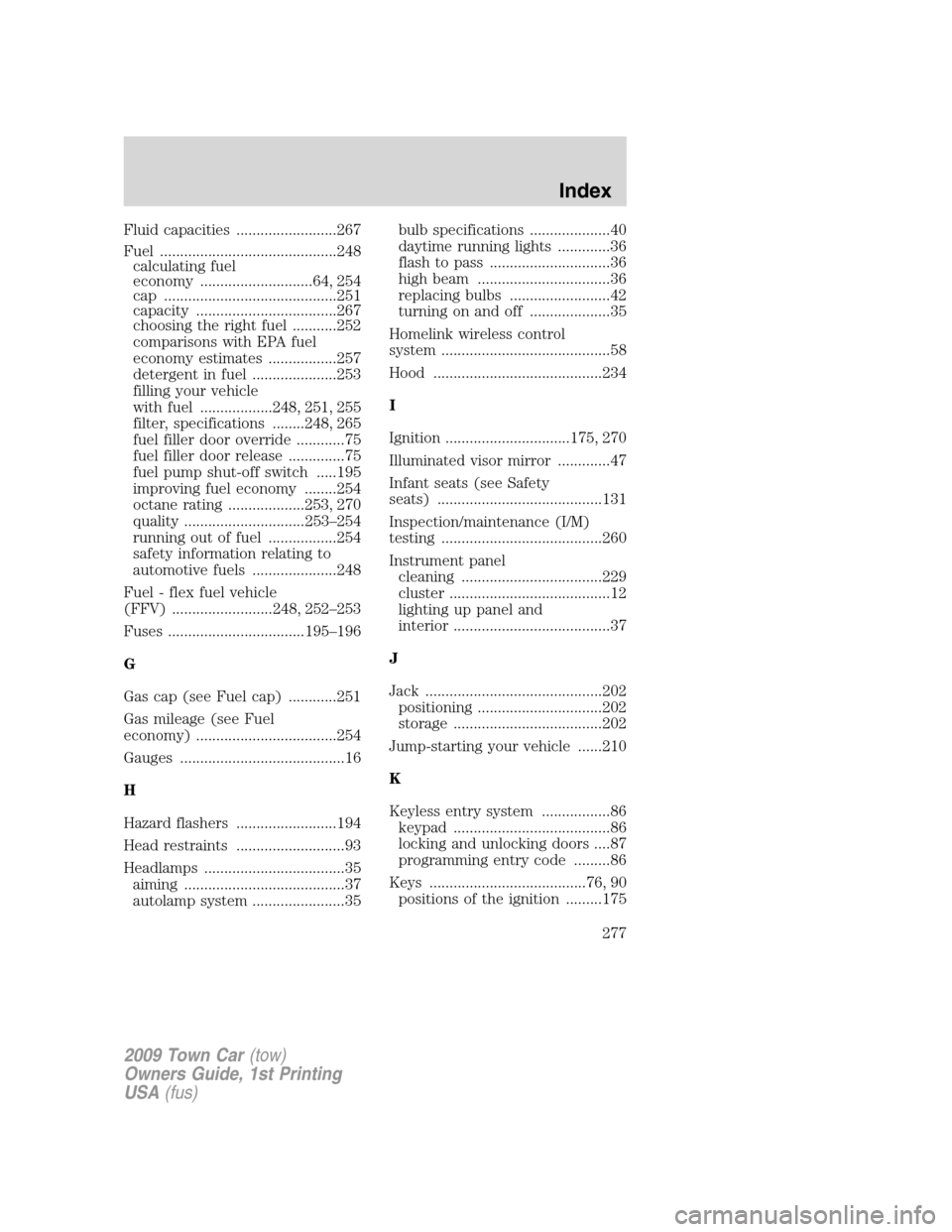
Fluid capacities .........................267
Fuel ............................................248
calculating fuel
economy ............................64, 254
cap ...........................................251
capacity ...................................267
choosing the right fuel ...........252
comparisons with EPA fuel
economy estimates .................257
detergent in fuel .....................253
filling your vehicle
with fuel ..................248, 251, 255
filter, specifications ........248, 265
fuel filler door override ............75
fuel filler door release ..............75
fuel pump shut-off switch .....195
improving fuel economy ........254
octane rating ...................253, 270
quality ..............................253–254
running out of fuel .................254
safety information relating to
automotive fuels .....................248
Fuel - flex fuel vehicle
(FFV) .........................248, 252–253
Fuses ..................................195–196
G
Gas cap (see Fuel cap) ............251
Gas mileage (see Fuel
economy) ...................................254
Gauges .........................................16
H
Hazard flashers .........................194
Head restraints ...........................93
Headlamps ...................................35
aiming ........................................37
autolamp system .......................35bulb specifications ....................40
daytime running lights .............36
flash to pass ..............................36
high beam .................................36
replacing bulbs .........................42
turning on and off ....................35
Homelink wireless control
system ..........................................58
Hood ..........................................234
I
Ignition ...............................175, 270
Illuminated visor mirror .............47
Infant seats (see Safety
seats) .........................................131
Inspection/maintenance (I/M)
testing ........................................260
Instrument panel
cleaning ...................................229
cluster ........................................12
lighting up panel and
interior .......................................37
J
Jack ............................................202
positioning ...............................202
storage .....................................202
Jump-starting your vehicle ......210
K
Keyless entry system .................86
keypad .......................................86
locking and unlocking doors ....87
programming entry code .........86
Keys .......................................76, 90
positions of the ignition .........175
2009 Town Car(tow)
Owners Guide, 1st Printing
USA(fus)
Index
277